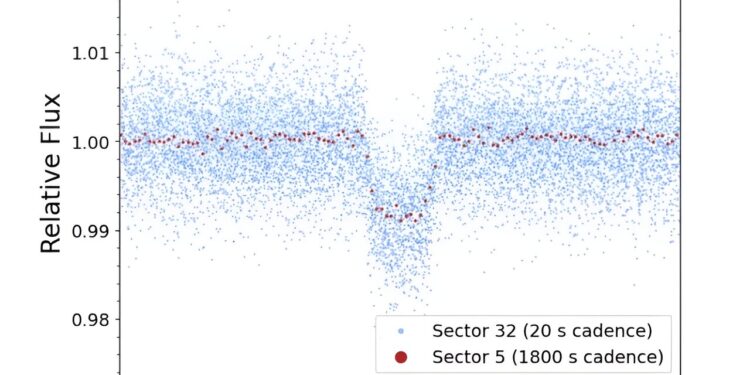TESS phase-folded light curve of TOI-2490, showing the relative flow of 30 minutes (1800 s) of sector 5 (red) and 20 seconds of cadence 32 (blue), zoomed in on the transit. Credit: Henderson et al., 2024.
An international team of astronomers has announced the discovery of a new brown dwarf, dubbed TOI-2490 b. The newly discovered object is about 74 times more massive than Jupiter and orbits a Sun-like star in a highly eccentric orbit. The discovery was detailed in a paper published August 8 on the preprint server arXiv.
Brown dwarfs (BDs) are objects intermediate between planets and stars, with masses between 13 and 80 times that of Jupiter (or between 0.012 and 0.076 solar masses). Although many brown dwarfs have been detected to date, these objects orbiting other stars are rare.
A group of astronomers led by Beth A. Henderson of the University of Leicester, UK, has discovered another transiting brown dwarf. Using TESS, a transit signal was identified in the light curve of TOI-2490, a Sun-like G-type main sequence star located about 872.5 light-years away. The brown dwarf nature of this signal was confirmed by follow-up photometric observations and radial velocity measurements.
“In this paper, we report the discovery of TOI-2490b, a new highly eccentric transiting brown dwarf discovered using TESS,” the researchers wrote.
According to the study, TOI-2490 is the size of Jupiter, while its mass is about 73.6 Jupiter masses, which gives a density at a level of 91.6 g/cm3The brown dwarf orbits its host star every 60.33 days, at a distance of about 0.31 AU. The equilibrium temperature of TOI-2490 b is estimated to be 464.2 K.
The observations revealed that TOI-2490 b has an orbital eccentricity of about 0.78. Astronomers noted that this result makes TOI-2490 b the most eccentric brown dwarf in the BD desert, i.e. the absence of brown dwarfs around main sequence stars within about 3 AU of the host.
Analyzing the collected data, the authors of the study concluded that TOI-2490 b likely formed with this high level of eccentricity. They added that this brown dwarf likely formed via star formation mechanisms and is assumed to have a metallicity and age similar to those of its parent star.
The study also revealed that the irradiation temperature of TOI-2490 b changes by about 1,000 K (from 545 to 1,552 K) as it travels around its orbit. However, further observations are needed to fully understand such an extreme change.
As for the properties of the host star, TOI-2490, it is as massive as the Sun and its radius is estimated to be about 1.1 solar radii. The star is estimated to be 7.9 billion years old, has a metallicity of 0.32 dex and its effective temperature has been estimated to be 5,558 K.
More information:
Beth A. Henderson et al, TOI-2490b- The most eccentric brown dwarf transiting the brown dwarf desert, arXiv (2024). DOI: 10.48550/arxiv.2408.04475
Journal information:
arXiv
© 2024 Science X Network
Quote:Discovery of a new massive and eccentric brown dwarf (August 14, 2024) retrieved August 14, 2024 from
This document is subject to copyright. Apart from any fair dealing for the purpose of private study or research, no part may be reproduced without written permission. The content is provided for informational purposes only.



